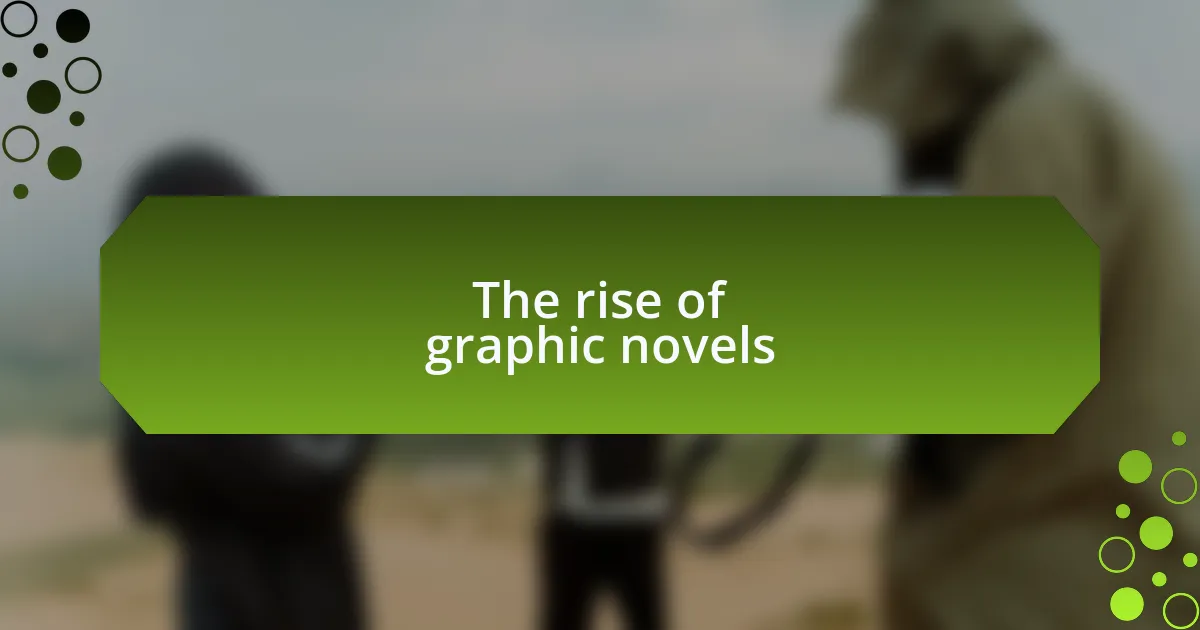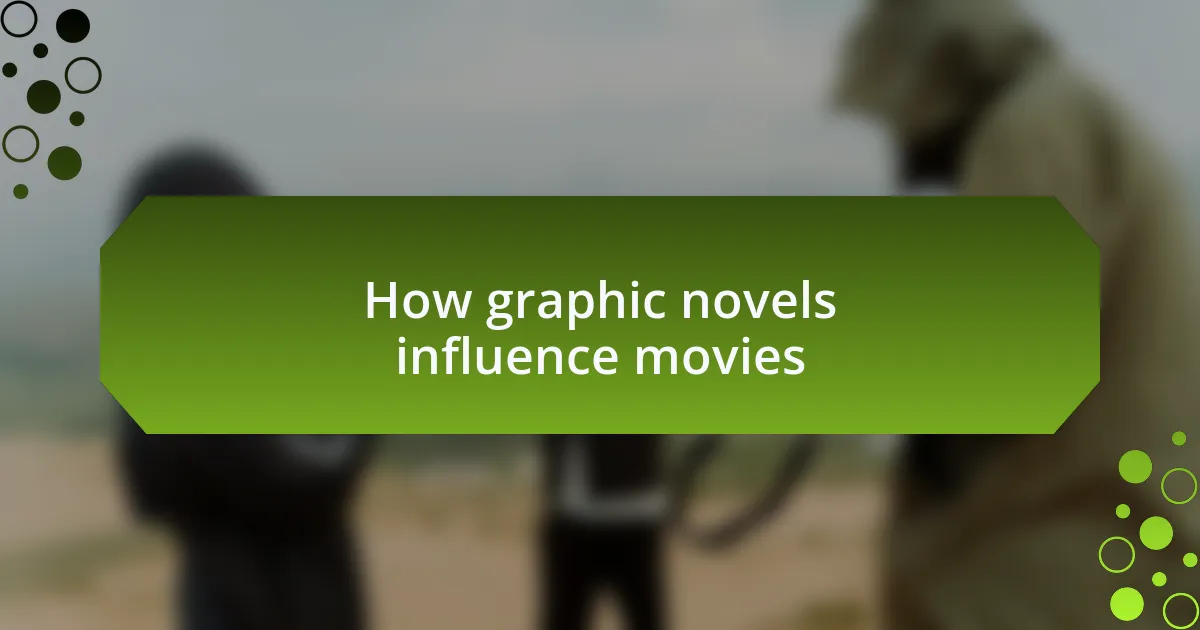Key takeaways:
- Graphic novels combine art and literature to convey complex themes and emotions, enhancing storytelling through visual elements.
- The rise in popularity of graphic novels is driven by their accessibility, diverse genres, and the ability to tackle deep issues in engaging ways.
- Graphic novels influence movies by enriching character development, employing vivid imagery, and impacting pacing, as seen in adaptations like “Sin City” and “Watchmen.”
- Personal recommendations include “Maus” for its historical depth, “Saga” for its unique blend of genres, and “Persepolis” for its autobiographical insights into political events.

Understanding graphic novels
Graphic novels might seem like just illustrated books, but they represent a unique storytelling medium that combines art and literature in a powerful way. I remember the first time I picked up a graphic novel; the vivid artwork drew me in, but it was the depth of the narrative that truly captivated me. Have you ever felt so connected to a character that their journey lingered in your mind long after you closed the book? That’s the beauty of graphic novels.
What sets graphic novels apart is their ability to convey complex themes through visual storytelling. I recall getting lost in “Maus” by Art Spiegelman, a book that marries history with artistry. The way the illustrations shaped my understanding of the Holocaust was both profound and moving. It’s a stark reminder of how images can evoke emotions that words alone might struggle to capture.
Moreover, the format of graphic novels allows for a dynamic pacing that traditional novels often lack. With panels and visual sequences, the rhythm of the story flows in a unique way. I often find myself reflecting on the sheer power of imagery—how a single frame can elicit laughter or tears. How do illustrations impact your interpretation of a story? Personally, they transport me, providing a rich layer of emotional experience that enhances the narrative in ways I’m still discovering.

The rise of graphic novels
The rise of graphic novels can be attributed to their ability to merge art and storytelling in an engaging manner. I still remember walking through a bookstore and being captivated by the colorful covers and intricate illustrations that seemed to leap off the shelf. Have you ever been drawn to a book simply by its cover? That’s exactly how I discovered titles like “Sandman” and “Bone,” and I couldn’t help but dive into the worlds they offered.
Over the years, graphic novels have gained recognition as a legitimate art form, appealing not just to children but also to adults seeking nuanced storytelling. I find it fascinating how creators like Alison Bechdel and Marjane Satrapi brought personal narratives to life in their works, sparking discussions about identity and culture. Isn’t it interesting how a comic can tackle such deep issues, making them accessible to a wider audience?
The digital age has played a significant role in their surge, as online platforms have made these works more accessible than ever. When I first explored webcomics, I was amazed to find a treasure trove of stories right at my fingertips. It felt like unlocking a hidden world, and I realized that graphic novels are evolving with technology, expanding their reach and influence rapidly. How have your own encounters with graphic novels changed in the era of streaming and digital media? For me, it continues to be a thrilling journey of discovery.

Key features of graphic novels
Graphic novels are distinguished by their unique blend of visuals and narrative, allowing readers to engage with complex stories in an immersive format. I remember the first time I realized that images could convey emotions just as powerfully as words. Every panel felt like a brushstroke on a larger canvas, drawing me deeper into the story as I followed the characters’ journeys. Do you feel a connection to a character through their expressions or the artwork that surrounds them?
Another essential feature is the diverse range of genres available within graphic novels. From fantasy to memoirs, there’s something for every taste. Personally, I’ve enjoyed exploring how genres like sci-fi can present thought-provoking themes while the vibrant illustrations create a captivating backdrop. How does the genre you prefer influence your reading experience or emotional connection to the story?
The pacing and layout in graphic novels also play a crucial role in storytelling. I find that the deliberate arrangement of panels can create tension or evoke a sense of urgency, guiding how you digest the narrative. For example, those longer panels with fewer words often hit harder, allowing the visuals to breathe and speak volumes. Have you noticed how varying panel sizes can change the tempo of a story? It’s this dynamic nature that keeps me turning pages, eager for what comes next.

My favorite graphic novel genres
When it comes to my favorite graphic novel genres, I find myself drawn to fantasy and science fiction. The imaginative worlds and intricate plots often take me on journeys beyond reality, which is something I crave as an escape from daily life. One of my fondest memories is immersing myself in a fantastical realm where dragons soared and quests were undertaken. Have you ever found yourself wishing you could step into a story? Those moments make me appreciate how graphic novels make the impossible feel tangible.
I also have a soft spot for memoir graphic novels. They put a unique spin on personal narratives that feels both intimate and relatable. There’s something powerful about seeing an author’s life experiences unfold through images and text. I recall a specific novel that documented the author’s struggles growing up; the raw emotion captured in those panels really resonated with me. Don’t you think visual storytelling can elevate personal stories to a different emotional plane?
Lastly, I can’t overlook the thrill of mysteries in graphic novels. The blend of suspenseful narratives and visual clues keeps my mind engaged, often leading to unexpected twists. I distinctly remember piecing together hints and clues alongside the characters. It felt like I was part of the investigation. Have you experienced that rush of excitement when a plot twist completely catches you off guard? That feeling is what keeps me coming back to graphic novels time and again.

How graphic novels influence movies
Graphic novels have a unique way of broadening cinematic stories by weaving together complex narratives and rich visuals. One of my favorites is how films often borrow the stylistic elements of graphic novels, like the use of vivid imagery and dynamic panel layouts. For instance, when I saw “Sin City” for the first time, it was like stepping directly into the pages of a graphic novel. The stark contrast and bold lines transported me, making the entire experience feel extraordinary.
Another profound influence comes from character development. Graphic novels often have the space to explore backstories and motivations in ways that films might skim over. I remember reading “Watchmen” and feeling such a deep connection to Rorschach; his moral dilemmas added layers to his character that I didn’t see in the movie adaptation. Doesn’t it make you think about how much richness can be lost when complex characters are simplified for the screen?
Moreover, the rhythm of storytelling in graphic novels can impact pacing in films. I can’t help but notice how certain scenes mimic the feeling of turning pages, creating suspense or intensity. Watching movies like “300,” I felt as if I was flipping through its symbolic panels, each action scene carefully choreographed to reflect the weight of the graphic novel’s art. Isn’t it fascinating how sequential art can inspire filmmakers to think differently about time and movement in their narratives?

My personal graphic novel recommendations
When it comes to graphic novels, “Maus” stands out for me. It’s a heart-wrenching exploration of the Holocaust, depicted through the eyes of a son recounting his father’s experiences. The way Art Spiegelman uses anthropomorphism to illustrate different ethnicities—mice for Jews and cats for Germans—struck me deeply. Have you ever read something that changed your entire perspective on history? This novel certainly did that for me, opening my eyes to the personal stories behind the larger events.
Another recommendation is “Saga.” It’s a breathtaking blend of fantasy and sci-fi that dives into the intricacies of love, family, and war. The character dynamics in this series truly resonated with me; I found myself rooting for characters like Alana and Marko despite their fraught circumstances. How often do you encounter stories that make you question your definitions of right and wrong? “Saga” challenges you to think about these themes in ways that are remarkably refreshing.
Lastly, I can’t leave out “Persepolis.” This autobiographical graphic novel gave me invaluable insights into the Iranian Revolution from a child’s perspective. Marjane Satrapi’s honest depiction of her youth in a tumultuous environment left me feeling both inspired and saddened. It made me reflect on the privileges I often take for granted. Have you ever read something that made international events feel so personal? This graphic novel did just that for me, bridging the gap between the political and the personal.